engine VAUXHALL COMBO 2015 Owner's Manual
[x] Cancel search | Manufacturer: VAUXHALL, Model Year: 2015, Model line: COMBO, Model: VAUXHALL COMBO 2015Pages: 183, PDF Size: 4.28 MB
Page 5 of 183

Introduction3Vehicle specific data
Please enter your vehicle's data on
the previous page to keep it easily
accessible. This information is
available in the sections "Service and maintenance" and "Technical data"
as well as on the identification plate.
Introduction
Your vehicle is a designed
combination of advanced technology, safety, environmental friendliness
and economy.
This Owner's Manual provides you
with all the necessary information to
enable you to drive your vehicle
safely and efficiently.
Make sure your passengers are
aware of the possible risk of accident
and injury which may result from
improper use of the vehicle.
You must always comply with the
specific laws and regulations of the
country that you are in. These laws
may differ from the information in this Owner's Manual.When this Owner's Manual refers to aworkshop visit, we recommend your
Vauxhall Authorised Repairer. For
gas vehicles, we recommend a
Vauxhall Authorised Repairer
licensed to service gas vehicles.
All Vauxhall Authorised Repairers
provide first-class service at
reasonable prices. Experienced
mechanics trained by Vauxhall work
according to specific Vauxhall
instructions.
The customer literature pack should
always be kept ready to hand in the
vehicle.
Using this manual ■ This manual describes all options and features available for this
model. Certain descriptions,
including those for display and
menu functions, may not apply to
your vehicle due to model variant,
country specifications, special
equipment or accessories.
■ The "In brief" section will give you an initial overview.■ The table of contents at thebeginning of this manual and withineach section shows where the
information is located.
■ The index will enable you to search
for specific information.
■ This Owner's Manual depicts left- hand drive vehicles. Operation is
similar for right-hand drive vehicles.
■ The Owner's Manual uses the factory engine designations. The
corresponding sales designations
can be found in the section
"Technical data".
■ Directional data, e.g. left or right, or
front or back, always relate to the
direction of travel.
■ The vehicle display screens may not support your specific language.
■ Display messages and interior labelling are written in bold letters.
Page 18 of 183
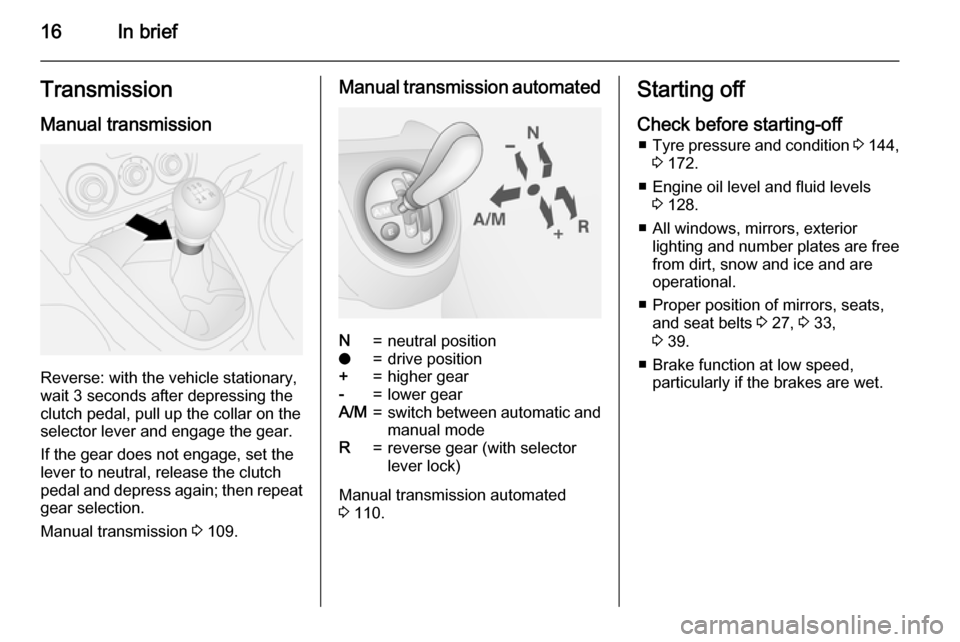
16In briefTransmission
Manual transmission
Reverse: with the vehicle stationary,
wait 3 seconds after depressing the
clutch pedal, pull up the collar on the
selector lever and engage the gear.
If the gear does not engage, set the
lever to neutral, release the clutch
pedal and depress again; then repeat
gear selection.
Manual transmission 3 109.
Manual transmission automatedN=neutral positiono=drive position+=higher gear-=lower gearA/M=switch between automatic and
manual modeR=reverse gear (with selector
lever lock)
Manual transmission automated
3 110.
Starting off
Check before starting-off ■ Tyre pressure and condition 3 144,
3 172.
■ Engine oil level and fluid levels 3 128.
■ All windows, mirrors, exterior lighting and number plates are free
from dirt, snow and ice and are
operational.
■ Proper position of mirrors, seats, and seat belts 3 27, 3 33,
3 39.
■ Brake function at low speed, particularly if the brakes are wet.
Page 19 of 183
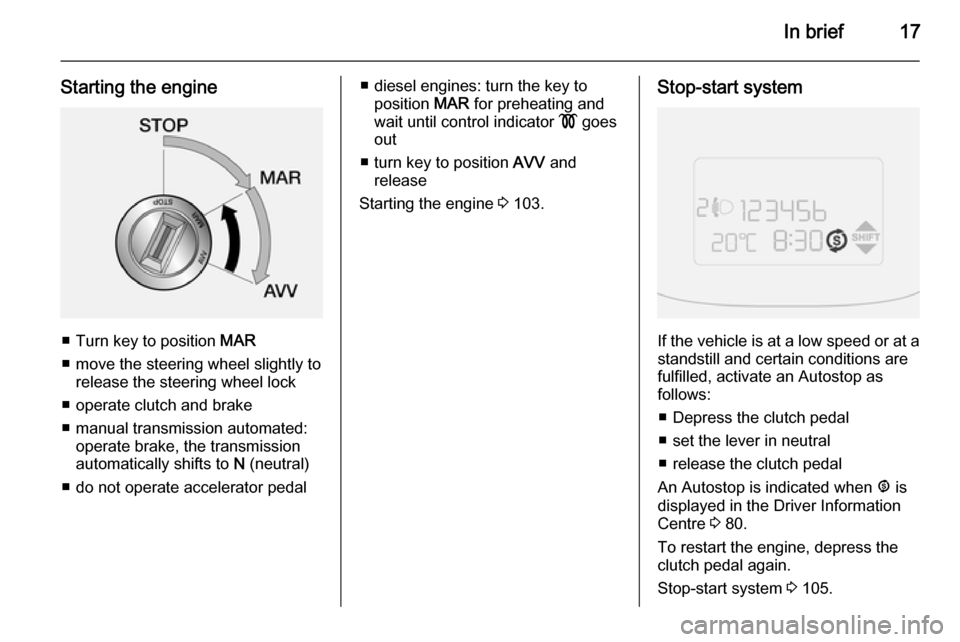
In brief17
Starting the engine
■ Turn key to position MAR
■ move the steering wheel slightly to release the steering wheel lock
■ operate clutch and brake
■ manual transmission automated: operate brake, the transmission
automatically shifts to N (neutral)
■ do not operate accelerator pedal
■ diesel engines: turn the key to position MAR for preheating and
wait until control indicator ! goes
out
■ turn key to position AVV and
release
Starting the engine 3 103.Stop-start system
If the vehicle is at a low speed or at a
standstill and certain conditions are
fulfilled, activate an Autostop as
follows:
■ Depress the clutch pedal
■ set the lever in neutral
■ release the clutch pedal
An Autostop is indicated when ^ is
displayed in the Driver Information
Centre 3 80.
To restart the engine, depress the
clutch pedal again.
Stop-start system 3 105.
Page 20 of 183

18In briefParking9Warning
■ Do not park the vehicle on an
easily ignitable surface. The
high temperature of the exhaust system could ignite the surface.
■ Always apply parking brake without pressing release button.Apply as firmly as possible on a
downhill slope or uphill slope.
Depress foot brake at the same
time to reduce operating force.
■ Switch off the engine. Turn the ignition key to position STOP
and remove it. Turn the steering
wheel until the steering wheel
lock is felt to engage.
■ If the vehicle is on a level surface or uphill slope, engage
first gear before switching off the ignition. On an uphill slope, turn
the front wheels away from the
kerb.
If the vehicle is on a downhill
slope, engage reverse gear
before switching off the ignition. Turn the front wheels towards
the kerb.
■ Close the windows.
■ Lock the vehicle with button e on
the radio remote control.
■ The engine cooling fans may run after the engine has been switched
off 3 127.
■ After running at high engine speeds
or with high engine loads, operate the engine briefly at a low load or
run in neutral for
approx. 30 seconds before
switching off, in order to protect the turbocharger.
Keys, locks 3 19, Laying the vehicle
up for a long period of time 3 126.
Page 29 of 183
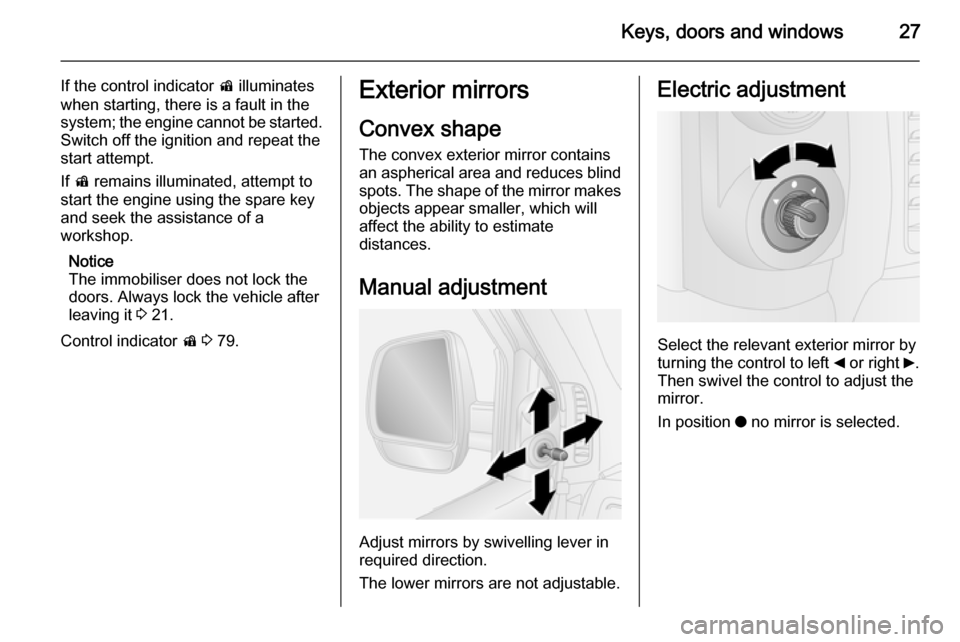
Keys, doors and windows27
If the control indicator d illuminates
when starting, there is a fault in the system; the engine cannot be started. Switch off the ignition and repeat the
start attempt.
If d remains illuminated, attempt to
start the engine using the spare key
and seek the assistance of a
workshop.
Notice
The immobiliser does not lock the
doors. Always lock the vehicle after
leaving it 3 21.
Control indicator d 3 79.Exterior mirrors
Convex shape
The convex exterior mirror contains
an aspherical area and reduces blind spots. The shape of the mirror makes objects appear smaller, which will
affect the ability to estimate
distances.
Manual adjustment
Adjust mirrors by swivelling lever in
required direction.
The lower mirrors are not adjustable.
Electric adjustment
Select the relevant exterior mirror by
turning the control to left _ or right 6.
Then swivel the control to adjust the
mirror.
In position o no mirror is selected.
Page 30 of 183
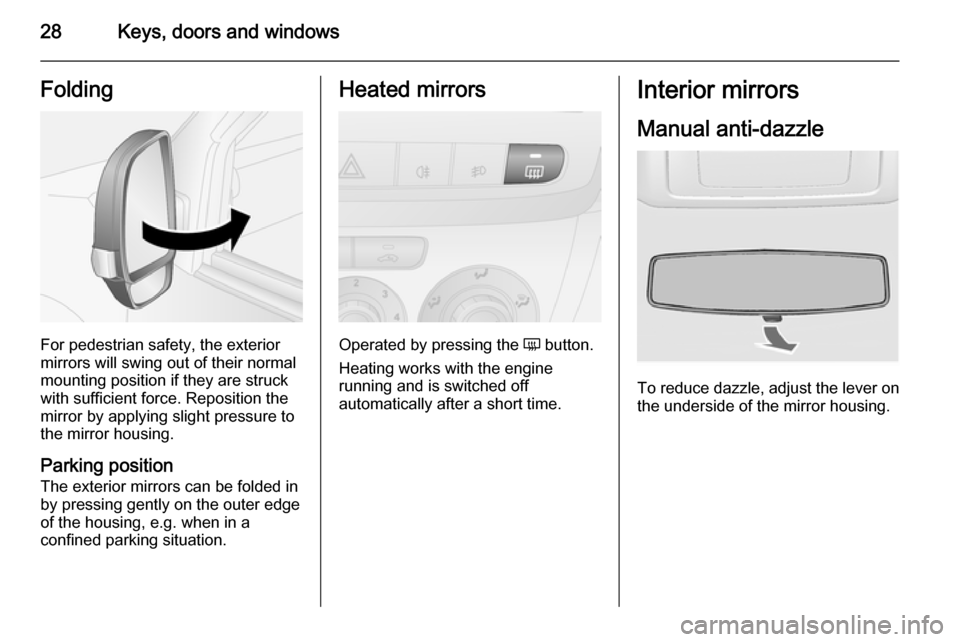
28Keys, doors and windowsFolding
For pedestrian safety, the exterior
mirrors will swing out of their normal
mounting position if they are struck
with sufficient force. Reposition the mirror by applying slight pressure tothe mirror housing.
Parking position
The exterior mirrors can be folded in
by pressing gently on the outer edge
of the housing, e.g. when in a
confined parking situation.
Heated mirrors
Operated by pressing the Ü button.
Heating works with the engine
running and is switched off
automatically after a short time.
Interior mirrors
Manual anti-dazzle
To reduce dazzle, adjust the lever on the underside of the mirror housing.
Page 33 of 183
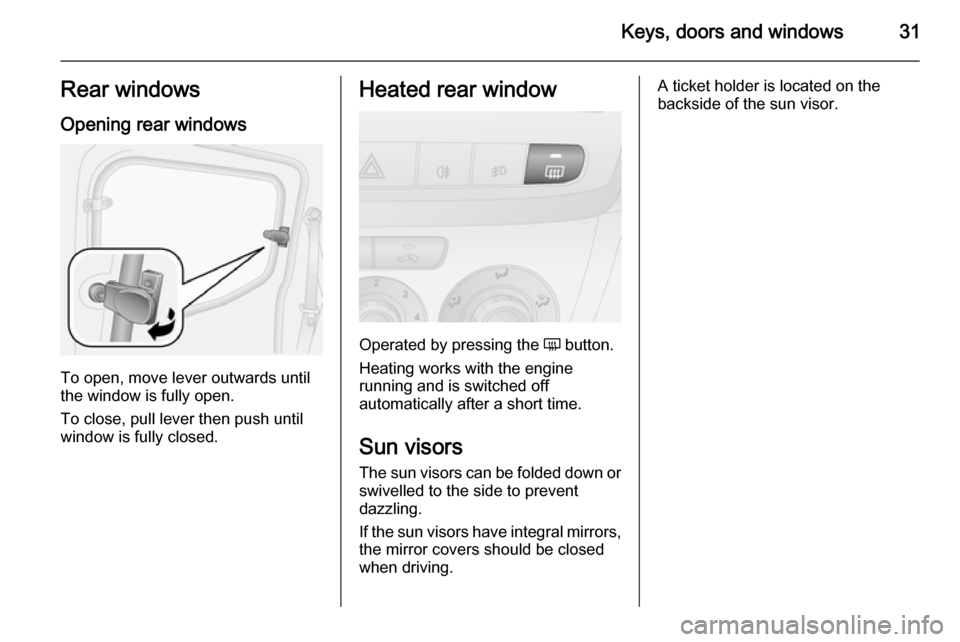
Keys, doors and windows31Rear windows
Opening rear windows
To open, move lever outwards until
the window is fully open.
To close, pull lever then push until
window is fully closed.
Heated rear window
Operated by pressing the Ü button.
Heating works with the engine
running and is switched off
automatically after a short time.
Sun visors The sun visors can be folded down orswivelled to the side to prevent
dazzling.
If the sun visors have integral mirrors, the mirror covers should be closed
when driving.
A ticket holder is located on the
backside of the sun visor.
Page 37 of 183
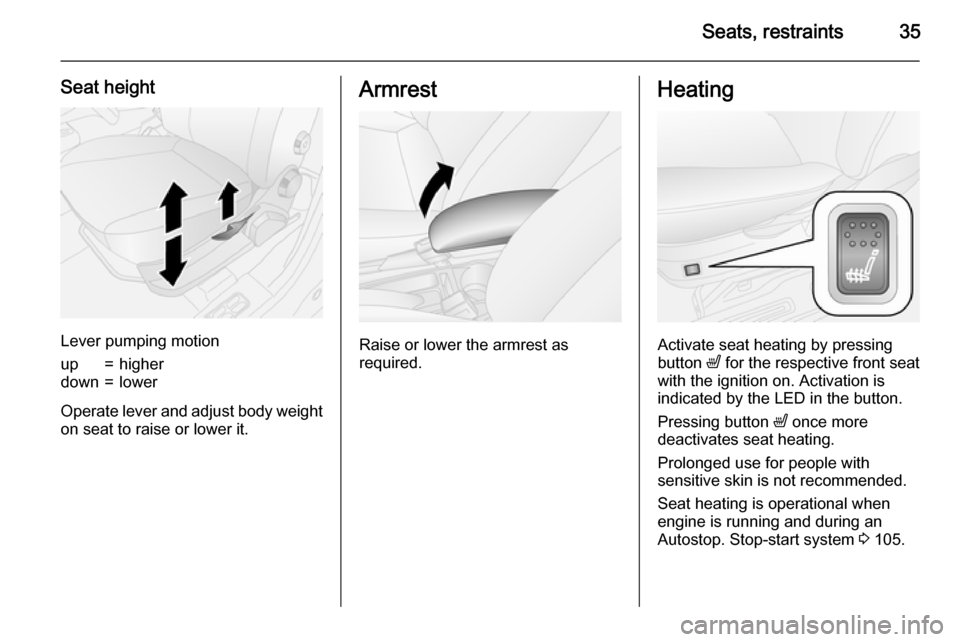
Seats, restraints35
Seat height
Lever pumping motion
up=higherdown=lower
Operate lever and adjust body weight
on seat to raise or lower it.
Armrest
Raise or lower the armrest as
required.
Heating
Activate seat heating by pressing
button ß for the respective front seat
with the ignition on. Activation is
indicated by the LED in the button.
Pressing button ß once more
deactivates seat heating.
Prolonged use for people with
sensitive skin is not recommended.
Seat heating is operational when
engine is running and during an
Autostop. Stop-start system 3 105.
Page 43 of 183

Seats, restraints41Airbag system
The airbag system consists of a
number of individual systems
depending on the scope of
equipment.
When triggered, the airbags inflate
within milliseconds. They also deflate
so quickly that it is often unnoticeable during the collision.
Notice
Depending on the severity of a
collision, the fuel system may also be cut-off and the engine switched
off automatically, for safety reasons.
Resetting the fuel cut-off system;
refer to "Fuel system messages"
3 86.
Notice
Expiry dates for replacing the airbag system components may be found
on the label inside the glovebox.
Contact a workshop to have the
airbag system components
replaced.9 Warning
If handled improperly the airbag
systems can be triggered in an
explosive manner.
Notice
The airbag systems and belt
pretensioner control electronics are
located in the centre console area.
Do not put any magnetic objects in
this area.
Do not fix any objects onto the airbag
covers and do not cover them with
other materials.
Each airbag is triggered only once.
Have deployed airbags replaced by
a workshop. Furthermore, it might be necessary to have the steering
wheel, the instrument panel, parts of
the panelling, the door seals,
handles and the seats replaced.
Do not make any modifications to
the airbag system as this will
invalidate the vehicle type approval.
9 Warning
When the airbags inflate, escaping
hot gases may cause burns.
Control indicator v for airbag systems
3 74.
Fault If there is a fault in the airbag and belttensioner system, the control
indicator v illuminates in the
instrument cluster. The system is not
operational.
Have the cause of the fault remedied
by a workshop.
Control indicator v 3 74.
Child restraint systems on front passenger seat with airbag
systems
Warning according to ECE R94.02:
Page 70 of 183
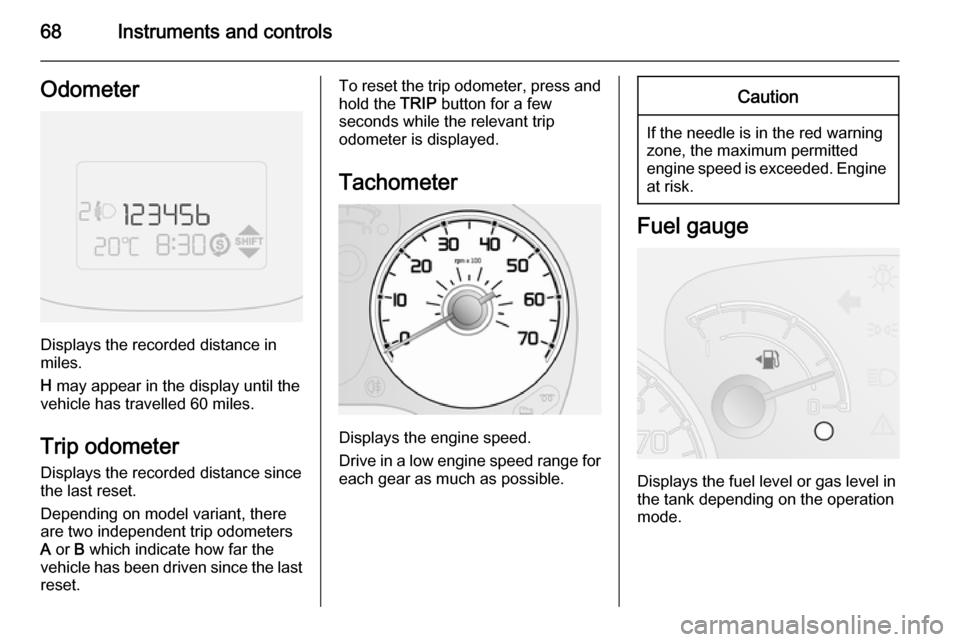
68Instruments and controlsOdometer
Displays the recorded distance in
miles.
H may appear in the display until the
vehicle has travelled 60 miles.
Trip odometer Displays the recorded distance since
the last reset.
Depending on model variant, there are two independent trip odometers
A or B which indicate how far the
vehicle has been driven since the last
reset.
To reset the trip odometer, press and hold the TRIP button for a few
seconds while the relevant trip odometer is displayed.
Tachometer
Displays the engine speed.
Drive in a low engine speed range for each gear as much as possible.
Caution
If the needle is in the red warning
zone, the maximum permitted
engine speed is exceeded. Engine at risk.
Fuel gauge
Displays the fuel level or gas level in
the tank depending on the operation
mode.